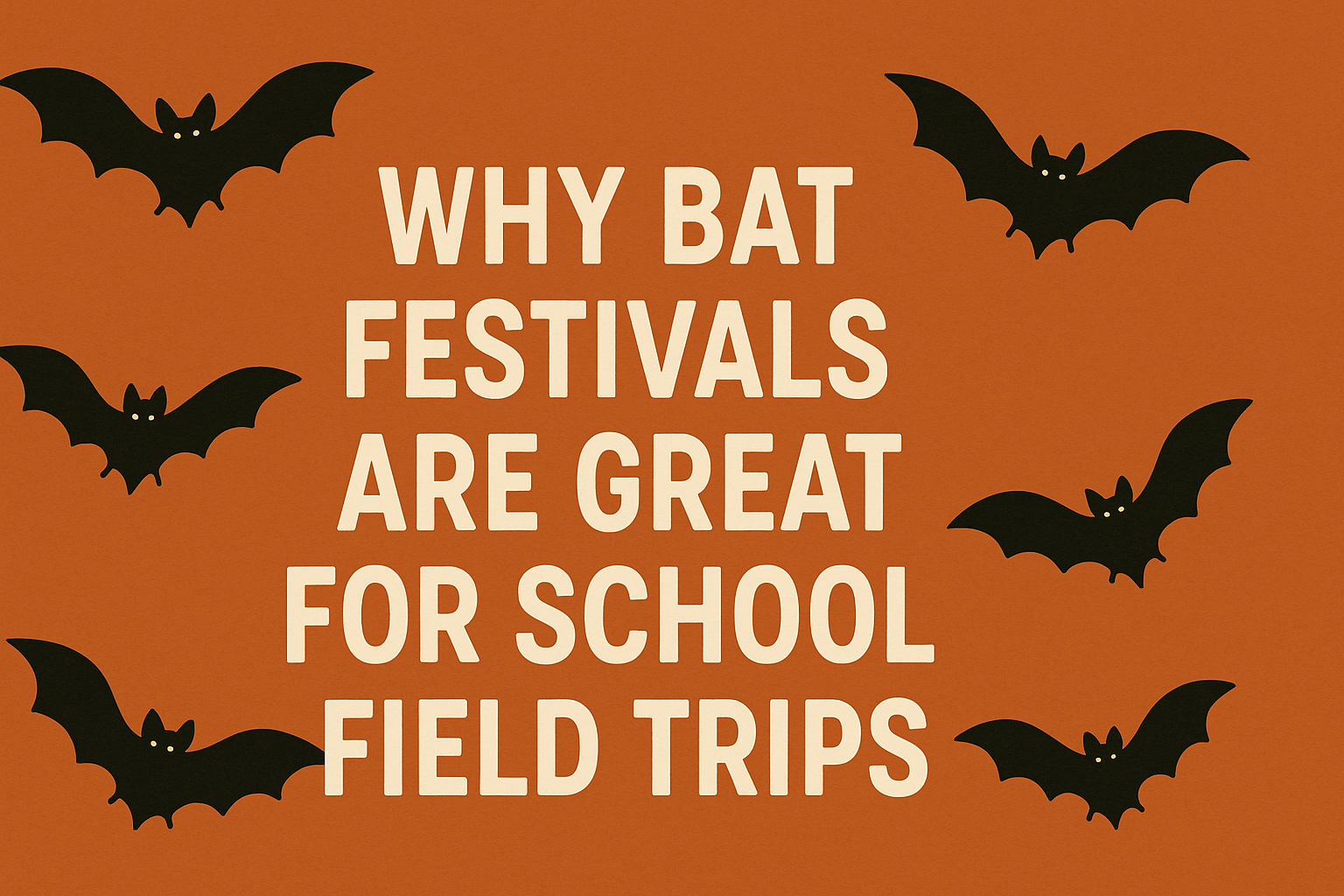Let’s be honest—when it comes to school field trips, the usual options can get a bit… predictable. Museum? Been there. Zoo? Check. Planetarium? Awesome, but again?
But what if we told you there’s an event that combines science, storytelling, conservation, crafts, and actual live animals—and it happens every year in a way that’s hands-on, exciting, and totally unique?
Enter: the Bat Festival.
Yup, you heard that right. A whole festival dedicated to bats. And no, it’s not just a Halloween gimmick. It’s one of the most underrated, curriculum-friendly, and kid-approved field trips out there.
Let’s break down exactly why bat festivals are perfect for school field trips—and how they tick all the boxes for educators, students, and parents alike.
1. Bats = Science in Action
Bat festivals are a dream come true for science teachers. Why? Because bats touch so many scientific concepts in one swoop:
Topics covered:
- Animal adaptations
- Echolocation & sound waves
- Nocturnal behavior
- Ecosystems and food chains
- Biodiversity and conservation
- Mammal classification
- Disease ecology (White-Nose Syndrome)
Hands-on learning activities include:
- Echolocation games
- Live bat demonstrations
- Build-a-bat activities
- Insect scavenger hunts
- Bat anatomy stations
It’s like a living, flying biology textbook—except your students are having fun and retaining the info.
2. It Reinforces Core Curriculum (Without Feeling Like School)
The best kind of learning happens when students don’t even realize they’re learning. That’s exactly what bat festivals do.
Connections to curriculum:
| Subject | How It Connects |
|---|---|
| Science | Life cycles, ecosystems, animal behavior |
| Math | Bat wing measurements, population stats, bug count charts |
| Language Arts | Bat-themed storytime, journaling, vocabulary scavenger hunts |
| Art | Bat mask making, painting wings, designing habitats |
| Social Studies | Cultural myths about bats around the world |
You can even have students write reflections after the trip, create a bat report, or make posters with bat facts they learned.
3. It’s Kid-Friendly, Interactive, and Totally Memorable
Let’s be real—kids love anything that involves:
- Costumes
- Animals
- Touch-and-feel exhibits
- Making stuff
- Saying “eww!” at insect displays
Bat festivals offer all of that—plus:
- Face painting
- Puppet shows
- Bat-themed snacks
- Games like “Pin the Wings on the Bat” or “Mosquito Tag”
- Live bat presentations with real scientists
For many students, it’s the first time they’ll ever see a bat up close, learn it’s not scary, and start seeing wildlife as something worth protecting.
4. They Take Place Outdoors or in Nature Centers
Most bat festivals are hosted by:
- Nature centers
- Local wildlife organizations
- State parks
- University science departments
That means students are getting fresh air, real-world context, and a break from the classroom. Whether it’s walking a trail on a bat scavenger hunt or exploring local flora and fauna, it adds a deeper level of connection to nature.
Bonus: These venues often have picnic areas, restrooms, and indoor space for bad weather—so it’s a safe and manageable environment for groups.
5. Real Scientists = Real Inspiration
Many bat festivals invite:
- Wildlife biologists
- Conservationists
- University researchers
- Environmental educators
This gives students a chance to interact with real-world scientists and see what it’s like to work in environmental science, biology, or wildlife conservation.
Just imagine your fifth graders chatting with a bat expert from Ohio State or a researcher who just got back from studying bats in Costa Rica.
That’s a field trip they’ll remember forever.
6. Great for All Ages and Abilities
Bat festivals are designed to be inclusive.
Whether your students are in 1st grade or high school, there are stations and sessions tailored for every age group and ability level.
- Crafts for younger kids
- STEM challenges for older students
- Quiet zones or sensory-friendly spaces for students with special needs
- Guided walks for different mobility levels
And because many events are self-guided with flexible pacing, teachers can adapt the experience to meet their group’s specific needs.
7. Affordable and Often FREE for Schools
Many bat festivals are:
- Free or low-cost
- Open to school groups
- Grant-supported or donation-based
- Hosted by nonprofits with education as their mission
Bonus savings:
- No pricey exhibits
- No fancy equipment needed
- Often close to home (local parks, colleges, or nature preserves)
It’s one of the most budget-friendly field trips with major educational return on investment.
8. Built-In Pre/Post Trip Activities
Here’s the part teachers love most: tons of free classroom resources.
Most bat festivals offer:
- Printable bat fact sheets
- Bat-themed worksheets
- Craft templates
- Pre-visit videos or reading lists
- Post-trip activity ideas (like journaling, presentations, or art projects)
This makes it easy to turn one field trip into a full week of bat-themed cross-curricular learning.
9. It Changes Perceptions and Sparks Stewardship
Many kids grow up afraid of bats.
They think bats are gross, scary, or dangerous.
But at a bat festival? They meet the real story:
- That bats are mammals
- That bats help us by eating insects
- That bats are in trouble—and need our help
- That bats are actually… kinda adorable
Suddenly, a field trip becomes something more—it becomes a spark. A student might go home and tell their family about building a bat house, or write a persuasive letter about saving habitats.
That’s the kind of learning that sticks.
Final Thoughts: Field Trip Goals = Reached
Bat festivals are:
- Fun
- Flexible
- Educational
- Affordable
- Memorable
- Conservation-focused
…which makes them a perfect field trip choice for schools, nature clubs, homeschool groups, or community youth programs.
So go ahead—plan that trip. Let the kids flap around in paper wings. Let them meet a bat in real life. Let them leave the festival knowing that science is cool, nature is worth protecting, and bats? Bats are awesome.
Want help planning a bat-themed field trip, or need a printable permission slip template? Just ask—I’ve got resources for teachers, scout leaders, and curious parents!




